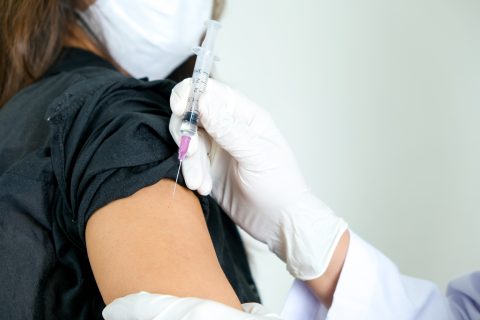Top Women’s Product Liability Lawsuits
This women’s lawsuit guide provides information on active lawsuits nationwide that affect women and their children. It also includes insights from top product liability lawyers who are actively litigating cases. Find out why women are suing and what it takes to qualify to file a claim.

Product Liability Lawsuits Unique to Women
When women are injured by the negligence of large corporations, they can file lawsuits for compensation. Harmful products in active lawsuits that are unique to women include birth control, cosmetics, drugs and medical devices.
If you’ve been injured by a product and want to file a lawsuit, you aren’t alone. As of March 2025, there are 83,756 active federal lawsuits against companies that make products alleged to have injured women.
These are some of the top lawsuits currently affecting women. If you have questions about your specific case, an experienced product liability lawyer can help.
Depo-Provera Birth Control Shot Lawsuit
The Depo-Provera shot is marketed as a convenient, effective and safe birth control option. However, a March 2024 study found women who used it had a 5.55-fold increased risk of developing meningioma, a tumor that grows in the lining of the brain.
Meningiomas aren’t typically fatal, but they can cause serious issues. Symptoms include headaches, seizures and vision or hearing problems.
“Gather all medical records that you can, including Depo-Provera prescriptions and diagnosis of meningioma. Consult an attorney experienced in pharmaceutical litigation to evaluate your case and guide you through the process.”
Lawyers are currently accepting cases from women who used Depo-Provera birth control and were diagnosed with a meningioma. Depo-Provera lawsuits claim makers failed to warn the public.
Paragard IUD Lawsuit
Cooper Surgical markets the Paragard IUD as a hormone-free, effective birth control that’s been FDA-approved since 1984. But, according to Paragard lawsuits, the Paragard IUD’s arms tend to break when removed, causing serious harm. Lawsuits list injuries such as surgery to remove the broken device, infertility that persists after removal and pain.
According to lawsuits, Cooper Surgical knew the IUD could break when removed but failed to warn about or fix these defects. Lawyers are currently accepting cases from women who had the Paragard break upon removal and had to have surgery to remove the fragments.
“After I got [the IUD] taken out and found out that the arm had broken off, I called my mom crying, really, really upset. ”
Since 2010, the FDA has received over 1,600 reports of the Paragard IUD breaking. Over 700 of these breakages were serious, according to a Paragard lawsuit filed by Demonica Hodges.
“After I got [the IUD] taken out and found out that the arm had broken off, I called my mom crying, really, really upset. And I found out my cousin had the same thing,” one Paragard user told Drugwatch. Her sister had it surgically removed and joined a lawsuit.”
Hair Relaxer Lawsuit
An October 2022 study in the Journal of the National Cancer Institute found that women who used hair relaxers at least four times a year were more than twice as likely to develop uterine cancer. Black women are most at risk because they are more likely to use these products.
After the study came out, women started filing chemical hair relaxer lawsuits claiming the products caused their cancer. Lawyers are accepting cases from people who developed uterine cancer, endometrial cancer and ovarian cancer.
“If there were a warning on those products, my wife Michele Lynn wouldn’t have kept using them.”
As of March 2025, 9,788 active cases are pending in the Northern District of Illinois.
“If there were a warning on those products, my wife Michele Lynn wouldn’t have kept using them. She would have stopped immediately. These companies put money before people’s lives, and all they care about is what’s hitting their bank account,” said Mike, the husband of a woman who developed breast cancer after using hair relaxers all her life.
Baby Formula NEC Lawsuit
Baby formula lawsuits don’t affect women directly, but they affect their children. These lawsuits claim infant formulas made with cow’s milk, like Similac or Enfamil, increase the risk of necrotizing enterocolitis (NEC) in premature infants.
NEC causes inflammation in the baby’s intestines, potentially leading to infections and tissue death in a baby’s gut. It may be fatal in up to 50% of cases.
“Parents of infants with NEC often endure emotional turmoil as they watch their child struggle in the neonatal intensive care unit.”
Lawsuits claim that research indicates a link between babies who were solely formula-fed and NEC. One study in the Lancet found NEC diagnosis was six to 10 times more common in formula-fed babies.
“Parents of infants with NEC often endure emotional turmoil as they watch their child struggle in the neonatal intensive care unit … In addition to the emotional and physical toll, families also face steep medical expenses that can create financial hardships,” said attorney Brendan Smith.
If your baby was born prematurely and developed NEC after consuming cow’s milk baby formula, you may consider filing a claim.
Talcum Powder Lawsuits
Women who filed talcum powder lawsuits claim the product can cause ovarian cancer when used in the genital area for several years. The main defendant in these cases is Johnson & Johnson. This litigation includes Johnson’s Baby Powder and other talcum powder products.
Judges consolidated some of the first talcum powder cases in New Jersey in 2016. Johnson & Johnson has been trying to settle these cases by transferring all its liability to a subsidiary called Red River Talc and putting that company into bankruptcy.
So far, the company has offered about $8 billion to settle claims. There are over 58,000 lawsuits in this litigation as of March 2025.
Lawyers are still accepting claims from women who developed ovarian cancer after long-term genital use of talcum powder. If you want to file a lawsuit, contact a lawyer immediately.
BioZorb Marker Lawsuit
BioZorb is an implantable radiographic device commonly used to mark soft tissue in the breast. Doctors may use the marker in women who need future treatment or procedures. If you’ve had breast cancer treatments, you might have this device.
It has two parts: a permanent titanium metal component and a dissolvable plastic component. The plastic part is supposed to be reabsorbed into the body after a year or more.
“Biozorb Markers are most often implanted in breast tissue as part of breast cancer treatment, which means that most if not all of those injured by the BioZorb Markers are women.”
In October 2024, Hologic Inc. removed BioZorb from the market after it received reports of device migration, discomfort, infection, pain and rash. In some cases, patients required additional medical treatment.
Lawyers are accepting BioZorb lawsuits where the device moved from its original location in the body or poked through the skin. In some cases, women also suffered fluid buildup in the breast.
“BioZorb Markers are most often implanted in breast tissue as part of breast cancer treatment, which means that most if not all of those injured by the BioZorb Markers are women. Women who want to file a BioZorb lawsuit should contact a lawyer to discuss their injuries and treatment,” said Marlene Goldenberg, a founding partner at Nigh Goldenberg Raso & Vaugn.
Allergan Breast Implant Lawsuits
Allergan recalled its Biocell textured breast implants and expanders after women who received these products were diagnosed with breast implant-associated anaplastic large cell lymphoma (BIA-ALCL).
After the recall, women began filing Allergan breast implant lawsuits, claiming that residue on Allergan’s textured implants causes BIA-ALCL to develop. 91% of BIA-ALCL cases happen in women with textured breast implants.
BIA-ALCL is an uncommon cancer found in women with breast implants. It’s a form of non-Hodgkin’s lymphoma, a cancer that affects the immune system. Without immediate treatment, it can be deadly.
Roughly 1,300 cases are pending in New Jersey, and lawyers are still accepting cases.
Taxotere Lawsuit
Taxotere is a chemotherapy drug that treats a variety of cancers, including breast cancer. While a common side effect of chemotherapy is hair loss, women who filed Taxotere lawsuits say the drug’s maker didn’t warn them it could cause permanent hair loss.
“Women who experienced disfiguring permanent alopecia as a result of the use of Taxotere suffer great mental anguish as well as economic damages, including but not limited to loss of work or inability to work due to significant psychological damage,”
As of March 2025, 8,852 lawsuits are pending in federal court.
There are also 315 eye injury lawsuits pending. In these cases, women received Taxotere to treat breast cancer and suffered permanent damage to their lacrimal systems, impacting tear production. Women who suffer from this side effect produce excessive tears, leading to swollen, watery eyes.
Transvaginal Mesh Lawsuits
Transvaginal mesh lawsuits, or pelvic mesh lawsuits, involve net-like mesh implants that surgeons use to treat pelvic organ prolapse and stress urinary incontinence.
Pelvic organ prolapse occurs when organs drop down from their normal position. It causes a bulge in the vagina and may happen to women because of pregnancy, menopause or childbirth.
Stress urinary incontinence happens when your bladder leaks during exertion or physical activity. The underlying cause is the weakening of the tissue that supports your urethra.
“My husband couldn’t understand why I was hurting all of the time, why I was crying myself to sleep at night in so much pain that I didn’t even want to be touched.”
Surgeons use mesh like a sling to hold up organs and the urethra. However, transvaginal meshes are linked to complications like bleeding, bowel issues, infection, punctured organs, urinary tract infections and more.
In 2019, the New York Times reported that settlements neared $8 billion. Lawyers continue to take cases across the country.
Tips for Women Filing Lawsuits
Consider speaking to an attorney when you want to file a lawsuit. Having an attorney is beneficial because product liability cases are complex.
Product liability attorney Brendan Smith from Simmons Hanly Conroy has handled several litigations that affect women, including Depo-Provera and hair relaxers. Here are his tips for filing a lawsuit.
- Detailed documentation of product use, medical diagnoses and treatments is crucial for a successful product liability claim.
- Each state has its own statute of limitations that limits how long you have to file.
- You should be proactive about gathering medical records and keeping track of your symptoms.
The time limit for filing a lawsuit might be as little as one year, so talk to an attorney immediately. Some lawyers will offer a free case review for product liability lawsuits.
“Consulting with an attorney early can help ensure the strongest possible claim against a negligent manufacturer or distributor,” said Smith.
What Happens If I’ve Been Affected by More than One Product?
You might be injured by more than one of the products listed above. For example, it’s not uncommon for women to use birth control at the same time as another drug, medical device or product.
If this sounds like you, don’t worry. Experienced lawyers can help you file multiple claims.
“Facing multiple injuries at once can be physically draining, financially burdensome and emotionally overwhelming, as overlapping symptoms and medical treatments often require more extensive documentation and legal coordination.”
Smith found that some of his clients had used hair straighteners, Depo-Provera and baby formulas. They suffered injuries from a combination of products.
“Facing multiple injuries at once can be physically draining, financially burdensome, and emotionally overwhelming, as overlapping symptoms and medical treatments often require more extensive documentation and legal coordination. It is vital to distinguish the impact each product has had on their health and to address every potential defendant’s responsibility,” Smith said.
Editor Lindsay Donaldson contributed to this article.
Calling this number connects you with a Drugwatch.com representative. We will direct you to one of our trusted legal partners for a free case review.
Drugwatch.com's trusted legal partners support the organization's mission to keep people safe from dangerous drugs and medical devices. For more information, visit our partners page.






